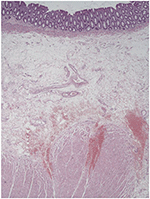

MethodĪ total of 14,245 patients underwent a stapled hemorrhoidopexy in this review and the complications reported were interpreted. It has allowed for a long-term collation of the complications associated with the procedures that have not been readily available and reported on, in the previously conducted randomized control trials (RCTs).

This review addressed and provided a review in regard to the complication rates of the stapled hemorrhoidopexy and has allowed for collation of data surrounding the major complications reported, within the literature, associated with this technique. Despite this, however, long-term sequelae of the stapled hemorrhoidopexy have not been widely documented and recent evidence has led to suspicion surrounding the complication rates of the procedure and how these actually compare with other techniques of hemorrhoidectomy. The technique has received enthusiasm as it was claimed that it could be completed with speed, minimal postoperative pain and good postoperative outcomes, in comparison with the previously used methods. The stapled hemorrhoidopexy was introduced in 1993 and has been used as an alternative method to the Ferguson and Milligan-Morgan technique for the surgical management of hemorrhoidal disease. Both early and late complications unique to stapled hemorrhoidopexy were identified and assessed. Complications unique to the procedure were identified and rates recorded. Early and late complications were defined individually with overall data suggesting that early complications ranged from 2.3%–58.9% and late complications ranged from 2.5%–80%. Overall complication rates of stapled hemorrhoidopexy ranged from 3.3%–81% with 5 mortalities documented. A total of 14,232 patients underwent a stapled hemorrhoidopexy in this review. The search identified 784 articles and 78 of these were suitable for inclusion in the review. Data extraction was conducted by both reviewers and entered and analyzed in Microsoft Excel. Two reviewers independently screened the abstracts for relevance and their suitability for inclusion. No language restrictions were placed on the search, however foreign language articles were not translated. Limitations were placed on the search criteria with articles published from 1998 to 2013 being included in this review. Articles were identified via searching OVID and MEDLINE between July 2011 and October 2013. Postoperative anal stenosis was more common after circular stapled hemorrhoidopexy with the ChexTM CPH32 stapler.A systematic review addressing reported complications of stapled hemorrhoidopexy was conducted. The volume of tissue excised by the Chex TM CPH32 and CPH34 staplers was significantly larger than in the PPH03 group (18.19 ± 9.67 mL 25.53 ± 13.99 mL 11.63 ± 5.66 mL p < 0.0001). There was no difference in complication rates between the three different devices, except for the occurrence of postoperative stenosis with more stricture formation when using the CPH32 stapler (p < 0.0001). Postoperatively, 28.5% of patients experienced minor early complications. One hundred and seventy-four patients were treated with the PPH03 stapler, 51 with the Chex TM CPH32 stapler and 28 with the Chex TM CPH34 stapler. We assessed early postoperative complications and complaints and compared the rate of complications between the three used devices.įrom 1 January 2008 to 30 December 2014, 253 patients underwent a SH using three different devices. The volume of the excised tissue was determined by reviewing the anatomopathologic reports. The demographic data were reviewed as well as indications for surgery. Three different devices were used: the PPH03 stapler (Ethicon EndoSurgery, Diegem, Belgium) and the Chex TM CPH32 and CPH34 staplers (Frankenman International Ltd, Hong Kong, China). A retrospective analysis was performed to assess differences between three devices used for stapled hemorrhoidopexy (SH) in terms of early complications and complaints and the volume of excised tissue.Īll patients who underwent an elective SH from January 2008 to December 2014 were included.


 0 kommentar(er)
0 kommentar(er)
